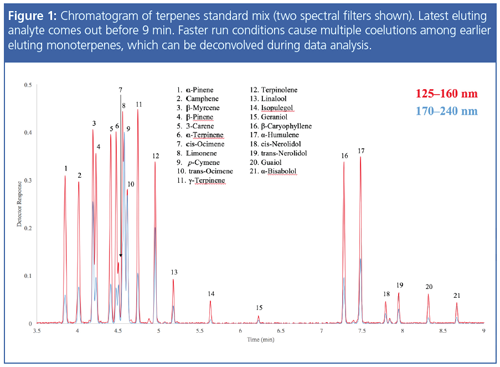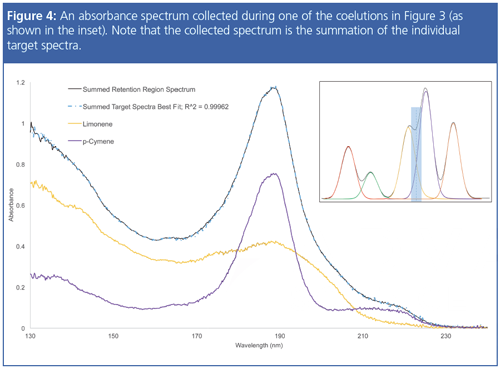Vacuum Ultraviolet Spectroscopy: A New Tool for Gas Chromatography Analysis of Terpenes in Flavours and Fragrances
The Column
Terpenes contribute heavily to the senses of smell and taste and thus are integral to industries like herb and spice producers, essential oil manufacturers, cannabis growers and distributors, breweries, and distilleries, among countless others. Current terpene analysis is performed using gas chromatography–flame ionization detection (GC–FID) and GC–mass spectrometry (MS); however, baseline separation is needed for quantification because many terpenes of interest are isomers, which can lead to relatively long run times. Vacuum ultraviolet (VUV) spectroscopy can spectrally distinguish isomers and quantitatively deconvolve coeluting peaks, allowing for significant reduction in GC run time. This article outlines a method for the analysis of 21 terpenes in a variety of samples with a sub 9-min elution time.
Photo Credit: Julia Albul/Shutterstock.com

Alex Hodgson and Jack Cochran, VUV Analytics Inc., Austin, Texas, USA
Terpenes contribute heavily to the senses of smell and taste and thus are integral to industries like herb and spice producers, essential oil manufacturers, cannabis growers and distributors, breweries, and distilleries, among countless others. Current terpene analysis is performed using gas chromatography–flame ionization detection (GC–FID) and GC–mass spectrometry (MS); however, baseline separation is needed for quantification because many terpenes of interest are isomers, which can lead to relatively long run times. Vacuum ultraviolet (VUV) spectroscopy can spectrally distinguish isomers and quantitatively deconvolve coeluting peaks, allowing for significant reduction in GC run time. This article outlines a method for the analysis of 21 terpenes in a variety of samples with a sub 9-min elution time.
Vacuum ultraviolet (VUV) spectroscopy has recently been coupled with gas chromatography (GC) to provide a new detection system to complement the existing technology. Almost all molecules absorb in the vacuum ultraviolet range (125–240 nm). The aggregate of electronic transitions from bonding or nonbonding orbitals to antiâbonding orbitals in this wavelength range produces unique absorbance spectra that allow for unambiguous identification, even for structural isomers. These absorbance spectra can then be used to deconvolve coeluting peaks with a high degree of accuracy. The ability to reliably resolve coelutions enables deliberate chromatographic compression through increased column flow and oven temperature program rates and subsequently shorter run times.
In this study, 21 terpenes of interest were analyzed in several matrices using GC–VUV and both headspace (HS) and solid-phase microextraction (SPME) sampling. Terpenes are a class of organic compounds produced mostly by plants and are used as building blocks in many biosynthetic pathways by fungi, plants, and animals (for example, endogenously synthesized steroids are derived from the triterpene squalene). All terpenes are built from multiple units of isoprene (C5H8), resulting in numerous isomeric configurations for each base molecular composition. The two most common classes of terpenes associated with odour and flavour are monoterpenes (two isoprene units) and sesquiterpenes (three isoprene units). They are the primary constituents in essential oils and are widely utilized in the food and fragrance, cosmetics, and pharmaceuticals industries (1,2).
Traditionally, terpenes are analyzed using GC–flame ionization detection (GC–FID) or GC–mass spectrometry (GC–MS); however, because FID is nonspecific and MS cannot differentiate structural isomers, analytes must be baseline separated for accurate quantitation. The additional separation burden associated with FID and MS leads to longer run times. VUV spectroscopy, on the other hand, accounts for the entire three-dimensional electronic structure of the molecule. Thus, the absorbance spectra of structural isomers can be distinguished visually, as well as electronically during the deconvolution process. A similar analysis was recently applied to terpenes in turpentines, but here terpenes in essential oils, hops, and gins are examined (3).
Method Conditions for HS-GC–VUV and SPME-GC–VUV
An Agilent 6890 GC system, a VUV Analytics VGA-100 spectrometer, and a Gerstel MPS2 autosampler were used to analyze all standards and samples. For headspace sampling, vials were incubated at 80 °C and agitated for 10 min; a 2-mL aliquot of sample was extracted at 90 °C for injection into the GC system. For SPME sampling, vials were incubated (with no agitation) for 10 min at 80 °C, followed by a 15-min extraction using a 50/30 μm DVB/CAR/PDMS fibre (Stableflex, 23 Ga) (Supelco); the fibre was desorbed in the inlet for 2 min. Injections were made into a 250 °C inlet with a 2.5:1 split. The column used was a 30 m × 0.25 mm, 1.40âμm Rxi-624Sil MS (Restek) with a constant flow rate of 4 mL/min helium. The initial oven temperature was 60 °C (held 0.1 min), then ramped at 23.8 °C/min to 300 °C. The transfer line and flow cell on the VGA-100 were held at 275 °C, and the makeup gas pressure was set at 0.25 psi nitrogen. Spectral data were acquired at 4 spectra per second.
Chromatographic Results
Run times for terpene analysis using GC–FID or GC–MS can be more than 30 min. Chromatographic compression by GC–VUV reduces the run time for this method to just over 10 min, with the last analyte eluting before 9 min (Figure 1). Several coelutions are noted for the early eluting monoterpenes, including between β-pinene and β-myrcene, between α-terpinene and cisâocimene, and between limonene, p-cymene, and transâocimene. Even though these monoterpenes are structural isomers (except p-cymene, which is a monoterpenoid), they all produce unique absorbance spectra (Figure 2). Because VUV absorbance is directly proportional to the concentration of analyte passing through the flow cell, as defined by the Beer-Lambert Law, these unique absorbance spectra can be used to deconvolve coeluting peaks accurately (Figure 3). Spectral data in Figure 4 shows one such deconvolution in this analysis: the absorbance spectrum collected during this coelution is simply the summation of the individual target spectra.




Analysis of Essential Oils
Essential oils are concentrated hydrophobic solutions of aroma compounds, the “essence” of a plant’s fragrance. Typical methods of terpene extraction include steam distillation, solvent extraction, and cold pressing of the plant matter, though some compounds are artificially synthesized (4). Six essential oils were analyzed by HS-GC–VUV: eucalyptus, lavender, neroli, peppermint, sweet orange, and tea tree. A 5- to 50-μL aliquot of each oil was spiked into 2 mL of water in a 20-mL headspace vial and run under the HS-GC–VUV method conditions. The essential oils with simple odour profiles, such as sweet orange and peppermint, had only one or two major peaks of interest (for example, limonene in sweet orange, menthol and eucalyptol in peppermint). Conversely, oils with more complex profiles had several major peaks, such as cis- and transâocimene, eucalyptol, and linalool in lavender and α-pinene, α- and γ-terpinene, and terpinolene in tea tree. One interesting result observed in this analysis was that no cis- or trans-nerolidol was detected in the neroli oil. This is an unexpected outcome given that these compounds derive their name from their discovery in the neroli flower.
Analysis of Hops
Hops are added to beer for flavouring and stability and contribute heavily to the bitter, spicy, zesty, and citric flavours of the beer (5). Two CO2-extracted hops samples were analyzed; approximately 1.25 g of each were placed neat into a 20-mL headspace vial and run under HSâGC–VUV method conditions. The most abundant terpenes in both samples were β-myrcene and β-pinene, at about 3 and 1.5 mg/g hops extract, respectively. The hops samples also had a few other terpenes in common (β-caryophyllene and farnesene), but there was an order of magnitude difference in concentration of these terpenes between samples. The more concentrated sample also had a more varied chromatographic profile, with several peaks present that were not observed in the lower concentration sample. This result reinforces the relationship between the chromatographic profile of hops strains and the distinct flavour they impart in beer.
Analysis of Gins
Gin is a class of liquor in which juniper berries and other botanicals are infused into an ethanol solution via distillation or cold compounding (6,7). Three gins from three different regions were analyzed using SPME-GC–VUV: an American contemporary, a London dry, and a Schwarzwald dry. In addition to juniper berries, five supplemental ingredients are listed in the American contemporary, nine in the London dry, and 46 in the Schwarzwald dry. As expected, the chromatograms (which are essentially the flavour profiles of the gins) reflected their respective ingredient profiles. The Schwarzwald had the most diverse profile and highest concentration of terpenes (14 targeted and at least three untargeted terpenes, with the targeted ranging from 5–950 pg/μL), whereas the American only had two terpenes of interest and in relatively lower concentrations (140 pg/μL linalool, 12 pg/μL geraniol). The London dry had a similar profile to the Schwarzwald but for the most part had lower concentrations of the targeted terpenes (3–170 pg/μL). The breadth and variety of ingredients added to gin is reflected in the price points, however, as observed by the higher selling price of the Schwarzwald relative to the other two.
Conclusions
A fast method using GC–VUV coupled with multiple sample introduction methods was used to identify and quantitate terpenes in several sample matrices. The uniqueness of VUV absorbance spectra, along with the fact that the VUV detector is always at ambient pressure and thus not flow limited, allows for deliberate chromatographic compression and shorter GC run times. This GC–VUV method analyzed 21 terpenes in less than 9 min. Coeluting peaks were deconvolved using unique absorbance spectra, leading to accurate identification and quantitation of analytes. This fast GC–VUV method extends beyond the realm of terpenes. Any application where chromatographic compression is a viable option or where coeluting isomer identification is a priority would benefit from this approach.
References
- L. Pazouki and U. Niinemets, Frontiers in Plant Science 7, 1019 (2016).
- E. Breitmaier, Terpenes: Flavors, Fragrances, Pharmaca, Pheromones (John Wiley & Sons. 2006).
- C. Qiu, J. Smuts, and K. Schug, Journal of Separation Science40(4), 869–877 (2017).
- W. Dhifi, S. Bellili, S. Jazi, N. Bahloul, and W. Mnif, Medicines 3, 25 (2016).
- C. Schönberger and T. Kostelecky, Journal of the Institute of Brewing117(3), (2012).
- N. Notman, Chemistry World (The Royal Society of Chemistry, 2017).
- S. Vichi, M. Riu-Aumatell, M. Mora-Pons, J. Guadayol, S. Buxaderas, and E. López-Tamames, Food Chemistry105(4), 1748–1754 (2007).
Alex Hodgson is an applications chemist at VUV Analytics, Inc. He earned a B.S. in biochemistry from the University of Texas at Austin and a M.S. in biochemistry at the Georgia Institute of Technology.
Jack Cochran is currently the Senior Director of Applications for VUV Analytics. He is a recognized expert in GC and GC×GC and uses his real-world experience in method development, sample preparation, and analysis to help chromatographers.
E-mail: alex.hodgson@vuvanalytics.com
Website:www.vuvanalytics.com

New TRC Facility Accelerates Innovation and Delivery
April 25th 2025We’ve expanded our capabilities with a state-of-the-art, 200,000 sq ft TRC facility in Toronto, completed in 2024 and staffed by over 100 PhD- and MSc-level scientists. This investment enables the development of more innovative compounds, a broader catalogue and custom offering, and streamlined operations for faster delivery. • Our extensive range of over 100,000 high-quality research chemicals—including APIs, metabolites, and impurities in both native and stable isotope-labelled forms—provides essential tools for uncovering molecular disease mechanisms and exploring new opportunities for therapeutic intervention.
New Guide: Characterising Impurity Standards – What Defines “Good Enough?”
April 25th 2025Impurity reference standards (IRSs) are essential for accurately identifying and quantifying impurities in pharmaceutical development and manufacturing. Yet, with limited regulatory guidance on how much characterisation is truly required for different applications, selecting the right standard can be challenging. To help, LGC has developed a new interactive multimedia guide, packed with expert insights to support your decision-making and give you greater confidence when choosing the right IRS for your specific needs.

.png&w=3840&q=75)

.png&w=3840&q=75)



.png&w=3840&q=75)



.png&w=3840&q=75)













